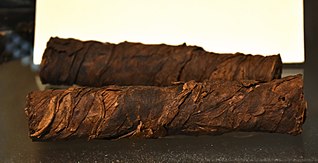The Ferme du tabac and the organisation of the Tobacco industry
By the mid century tobacco duties were worth more than 30 million livres a year to the French Crown - some 7% of fixed income - second in value only to the hated gabelle. Like the trade in salt, the tobacco trade was administered as a royal monopoly. In 1730, after a period of control by the Compagnie des Indes, the Ferme du tabac was incorporated into the "General-Farm". It was a huge undertaking. To maintain the tobacco monopoly effectively, every aspect of the importation, processing and sale of tobacco had to be overseen.
This map, which was prepared by Lavoisier in the 1780s, shows the Tobacco Farm's complex and highly regulated pattern of import and distribution. This level of control was made possible by the centralised organisation of the General-Farm with its specialised committees, directors and inspectors. From 1749 onwards the Comité du tabac occupied the magnificent 17th-century Hôtel de Longueville, situated in the centre of Paris between the Louvre and the Tuileries. From here the authority of the Farm extended directly through much of the Kingdom, with "sous-fermes" in the Lyonnais, Dauphiné, Provence, Languedoc, Roussillon and Lorraine.
The industry was based almost entirely on imported tobacco - outside a few enclaves, the cultivation of tobacco within France was strictly forbidden. Leaf tobacco arrived by sea in a handful of authorised ports: Bordeaux, Dieppe, Le Havre, Morlaix, Rouen, Sète, as well as overland to Valenciennes. It originated mainly in British America. Dried-leaf tobacco from Virginia and Maryland was purchased from colonial factors in England by agents of the Farm and shipped by English merchants operating out of Bristol or Glasgow. During the American War of Independence the Farm began to purchase directly from America. In 1785 a contract was signed with the American financier Robert Morris granting him the exclusive right to supply American tobacco. This was renewed in 1787 to the disappointment of those like Lafayette who advocated a free Franco-American trading market.
The imported leaf tobacco was processed in ten or so huge "Royal manufactories", the most important of which were situated in the Atlantic ports of Dieppe, Morlaix and Le Havre, in Marseille (closed in 1779) and in Paris. Each establishment was administered by an inspector or works manager, assisted by one or two controllers.
 |
| "Carotte"of tobacco, Musée de la Pipe et du Diamant, Saint-Claude File:Carotte tabac Saint-Claude 17072017.jpg - Wikimedia Commons |
From the manufactories the tobacco was sent to the bureaux généraux of the Farm whose warehouses supplied the retailers (débitants). Private freighters were employed, but precise itineraries and strict timetables were imposed to ensure security. No tobacco could be transported without the official seal of the Farm. This varied according to the product. "Cords" and pipe tobacco, carried a lead seal, many of which survive today. Packets of powder were was simply sealed with red wax bearing a stamp. "Carottes" of compressed tobacco for snuff would be bound in a string jacket threaded with a vignette, a paper label which carried the name of the official of the Farm, printed in different colours according to the quality of the tobacco.
 |
| Mid-century tobacco seals from Dieppe (superforum.fr) |
The bureaux covered areas roughly equivalent to the Royal Généralités and maintained a varying number of warehouses: eighteen for Orléans, eleven for Dijon, nine for Chalon-sur-Saône, seven for Nantes. These in turn supplied a designated set of détaillants. According to one estimate there were 43,000 authorised débitants in all; a surviving list from Nantes reveals that not all were necessarily specialised tobacco vendors, but included other merchants and tradesmen, plus a sprinkling of gardeners and servants. The Farm kept careful watch on the débitants and the regularity of their business arrangements [Jézéquel (2020) p.5-6].
It was the débitants who were required to pay the duty. Rates were set at an onerous level, usually several livres per pound of tobacco, which roughly doubled the price to the consumer (Price, p.498; quoted in Leizmeier, 2018 ). The high level of taxation was justified by the idea, widely contested at the time, that tobacco, unlike salt, was a luxury item. In reality tobacco was a staple in the eyes of working-class consumers. Punitive fines, and even imprisonment, for tax evasion added to the popular resentment and to the rapacious image of the Farm.
Faux-tabac - the fight against fraud
As was the case with the gabelle, the Tobacco Farm and its agents waged a constant war again smuggling. It is estimated that contraband tobacco, faux-tabac, could be bought at a tenth the price of the legitimate product.
The concealment by of illicit tobacco by retailers was a particularly intractable problem. In 1726 the Farm closed one source of fraud by securing a monopoly on the production of "carottes" of compressed tobacco. However, from the mid-century the growth in demand for pre-grated snuff created a new opportunity for retailers to introduce faux-tabac into their tobacco, or to adulterate it with water or ash. In 1759 the Comité du tabac discovered that the income from tobacco taxes had fallen by more than 20 percent, from 34 to 26 million livres, a decrease was to persist for more than a decade. It seemed that the Farm must prohibit tobacconists from grating too. In the final thirty years of the Ancien régime, conflict within the Farm between "pro-graters" and "anti-graters" became impassioned. Jacques Delahante, who in 1772 became president of the Comité du tabac was the most fervent advocate of a monopoly by the Farm; his descendant Andrien Delahante informs us that this goal was "the dream, the ambition, and the passion of his whole live" (Une famille de finance au xviiie siècle (1881), p.309). Lavoisier too favoured the graters. At the start of the Revolution, the issue remained unresolved, though most royal factories had by then taken over snuff production through the initiative of the individual Correspondant Farmer Generals.
https://archive.org/details/royalgeneralfarm0000matt.
https://histoire-de-la-douane.org/les-plombs-pour-sceller-au-xviiie-siecle-2-les-plombs-de-tabacs/




No comments:
Post a Comment